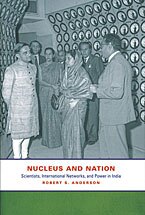Nucleus and Nation: Scientists, International Networks, and Power in India
DOI: 10.1063/1.3563824

I was a young physics student in India when the country conducted its first nuclear test on 18 May 1974 in the desert in Rajasthan. It took the world by surprise, not least because many found it inconceivable that the feat was achieved by a country beset with poverty and a lack of adequate industrial and technical infrastructure. For Indians, that “peaceful nuclear device” was a source of national pride and a matter of international prestige. But the test resulted in several nations placing severe sanctions on India, including a ban on technical equipment being shipped into the country. That ban adversely affected India’s research effort for nearly two decades. Indian laboratories and universities could not even import medium-sized computers or advanced oscilloscopes from the US during much of that period.
The test also led to the formation of the Nuclear Suppliers Group, a cartel of nuclear supplier countries that, according to its website, “seeks to contribute to the non-proliferation of nuclear weapons.” India’s nuclear weapons tests in May 1998 cemented its status as a world nuclear power; since then, subsequent agreements have been struck with the US and the suppliers group for civilian nuclear trade. India is now accepted as a de facto nuclear weapons state, even though it is not yet party to the Treaty on the Non-Proliferation of Nuclear Weapons.
In Nucleus and Nation: Scientists, International Networks, and Power in India, Robert Anderson traces the history, starting in the 1920s, of the country’s scientific research and institutions. He highlights what he believes are the efforts that formed the basis of India’s developments in nuclear power and space technology. He tells the stories of three Indian scientists—two physicists and one chemist—who formed the “nucleus” (referred to in the book’s cleverly punning title) that was instrumental in creating the scientific infrastructure that enabled the nuclear tests. Physicists Meghnad Saha and Homi Bhabha and chemist Shanti Swaroop Bhatnagar were not only first-rate scientists but also visionary leaders and founders of institutions that have since flourished. Indeed, some of India’s top scientists passed through those institutions, including my colleague Samir Bose, who worked as a young theoretical physicist in the 1960s at the Bhabha-founded Tata Institute of Fundamental Research.
Nucleus and Nation is a long book—nearly 600 pages of text, plus another 100 pages of notes. It is based primarily on material the author collected during an extended stay in India in the late 1960s while completing his dissertation, an anthropological study of the culture of the country’s science and scientific institutions. He was given extraordinary access to scientific institutions and archival material that was not generally available to Indian researchers at that time, and he had extensive conversations with the entire range of scientific workers—students, technicians, scientists, laboratory directors, even Vikram Sarabhai, then chairman of India’s Atomic Energy Commission. As a result, the author is able to discuss the contributions of the “nucleus” comprehensively and devoid of the uncritical, reverent treatment that Indian scientists of the time tended to accord those greats.
With a huge amount of information, Nucleus and Nation contains lots of interesting and, at times, quite amusing details. Nonetheless, it fails, in my opinion, to put all that information together in a coherent narrative that could have helped the reader reach definitive conclusions—the long “Conclusions” chapter notwithstanding. Moreover, the book is replete with errors and omissions, of physics and otherwise. Some of those are trivial, some quite important; in any event, the book would have greatly benefited from a look-over by a physicist and from the services of a fact checker.
The following are but a few examples: Bhabha and Walter Heitler developed the cascade theory of electronic showers, not Bhabha scattering (page 19), which is something different altogether; it would be a stretch to characterize James Chadwick as a “neutron theorist” (page 201); Daulat Singh Kothari never worked on “formation of neutron stars in white dwarfs” (page 222) and never worked at the National Physical Laboratory (page 224); Paul Dirac was married to Eugene Wigner’s sister, not daughter (page 70); Schrödinger’s first name was Erwin, not Ernst (page 70); Henry Kissinger’s famous trip to China and India’s treaty of friendship and cooperation with the Soviet Union both happened in 1971, not 1969 (page 433); India had a woman chief minister, Sucheta Kripalani, before Indira Gandhi became the prime minister (page 375); and India has 28 states, not 29 (page 5). Indeed, my list of such errors, by no means exhaustive, ran to almost two pages.
Despite those flaws, I think that a future researcher looking to craft a more cogent and error-free narrative will certainly find the voluminous information provided in Nucleus and Nation most useful.
More about the Authors
Umesh Garg . University of Notre Dame Notre Dame, Indiana.
